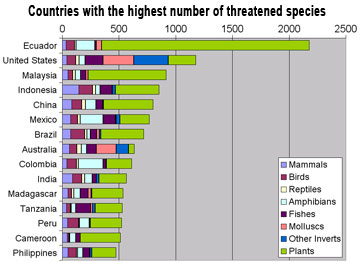Global wildlife populations decline 30% in 30 years
Global wildlife declines 30% in 30 years
mongabay.com
May 16, 2008
|
|
Nearly one third of the world’s wildlife has been lost since 1970, according to a study released by the Zoological Society of London, WWF and the Global Footprint Network.
Tracking nearly 4,000 populations trends for about 1,500 species, scientists from the environmental groups found that populations of wild species have declined by 30 percent on land and in freshwater and marine ecosystems. The current extinction rate is 10,000 times faster than the biological norm recorded in the fossil record.
“You’d have to go back to the extinction of the dinosaurs to see a decline as rapid as this,” ZSL scientist Jonathan Loh, editor of the report, said. “In terms of human times-scales we may be seeing things change relatively slowly, but a decline of 30 percent in the space of a single generation is unprecedented in human history.”

includes species listed as Critically Endangered (CR), Endangered (EN) or Vulnerable (VU) by IUCN, while the “extinct” chart includes species classified as “Extinct (EX)” or “Extinct in the Wild (EW)” on the Red List. Both charts include mammals, birds, reptiles, amphibians, fishes, mollusks, other invertebrates, and plants to the totals. |
The report cites habitat destruction, invasive species, overexploitation through hunting and harvesting, climate change, and pollution as the main causes of the decline. It says that human population growth and resource consumption are the ultimate driver of biodiversity loss.
To reverse the trend, the report recommends slowing greenhouse gas emissions, reducing the destruction of natural habitats, and reining in the over-fishing of commercial fish species.
The report was released ahead of a meeting of the Convention on Biodiversity in Bonn, Germany. The agreement, signed in 1992 with the intention of reducing biodiversity loss, set a goal in 2002 of achieving a “significant reduction” in the current rate of biodiversity loss by 2010, but the report says it is “very unlikely” that the 2010 target will be reached.
“It’s very damning for the governments that are party to the convention that they are not able to meet the target they set for themselves. The talk doesn’t get translated into action. We are failing, and the consequences will be devastating,” said Loh.
Related articles
Biodiversity extinction crisis looms says renowned biologist March 12, 2007
What do tigers in India, chameleons in Madagascar, redwood trees in California, and tube worms living in deep-sea hydrothermal vents have in common? They are all components of Earth’s biological diversity, or “biodiversity” for short. Biodiversity is the sum of all living organisms on the planet. It is also what makes life on Earth livable for our species. Biodiversity is the basis for ecological services that range from water filtration to food production to carbon cycling, and are worth tens of trillions of dollars per year. However, despite this importance, biodiversity is increasingly threatened. Human activities are fast diminishing the hotbeds of biological richness—rainforests, wetlands, coral reefs, and grasslands—and risk turning the planet into a biologically impoverished place. The implications for mankind could be quite serious. Ecologists warn that by extinguishing biodiversity, we risk our own quality of life, gamble with the stability of climate and local weather, threaten the existence of other species
Just how bad is the biodiversity extinction crisis? February 6, 2007
In recent years, scientists have warned of a looming biodiversity extinction crisis, one that will rival or exceed the five historic mass extinctions that occurred millions of years ago. Unlike these past extinctions, which were variously the result of catastrophic climate change, extraterrestrial collisions, atmospheric poisoning, and hyperactive volcanism, the current extinction event is one of our own making, fueled mainly by habitat destruction and, to a lesser extent, over-exploitation of certain species. While few scientists doubt species extinction is occurring, the degree to which it will occur in the future has long been subject of debate in conservation literature. Looking solely at species loss resulting from tropical deforestation, some researchers have forecast extinction rates as high as 75 percent.
